hnRNPA1 couples nuclear export and translation of specific mRNAs downstream of FGF-2/S6K2 signalling
- PMID: 25324306
- PMCID: PMC4227786
- DOI: 10.1093/nar/gku953
hnRNPA1 couples nuclear export and translation of specific mRNAs downstream of FGF-2/S6K2 signalling
Erratum in
-
Correction to 'hnRNPA1 couples nuclear export and translation of specific mRNAs downstream of FGF-2/S6K2 signalling'.Nucleic Acids Res. 2024 Jul 22;52(13):8034. doi: 10.1093/nar/gkae525. Nucleic Acids Res. 2024. PMID: 38874501 Free PMC article. No abstract available.
Abstract
The increased cap-independent translation of anti-apoptotic proteins is involved in the development of drug resistance in lung cancer but signalling events regulating this are poorly understood. Fibroblast growth factor 2 (FGF-2) signalling-induced S6 kinase 2 (S6K2) activation is necessary, but the downstream mediator(s) coupling this kinase to the translational response is unknown. Here, we show that S6K2 binds and phosphorylates hnRNPA1 on novel Ser4/6 sites, increasing its association with BCL-XL and XIAP mRNAs to promote their nuclear export. In the cytoplasm, phosphoS4/6-hnRNPA1 dissociates from these mRNAs de-repressing their IRES-mediated translation. This correlates with the phosphorylation-dependent association of hnRNPA1 with 14-3-3 leading to hnRNPA1 sumoylation on K183 and its re-import into the nucleus. A non-phosphorylatible, S4/6A mutant prevented these processes, hindering the pro-survival activity of FGF-2/S6K2 signalling. Interestingly, immunohistochemical staining of lung and breast cancer tissue samples demonstrated that increased S6K2 expression correlates with decreased cytoplasmic hnRNPA1 and increased BCL-XL expression. In short, phosphorylation on novel N-term sites of hnRNPA1 promotes translation of anti-apoptotic proteins and is indispensable for the pro-survival effects of FGF-2.
© The Author(s) 2014. Published by Oxford University Press on behalf of Nucleic Acids Research.
Figures
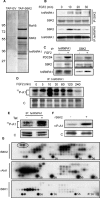
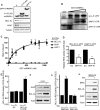
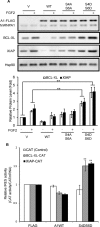
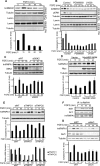
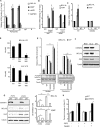

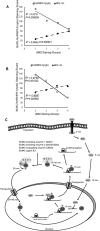
Similar articles
-
Tumor suppressor PDCD4 represses internal ribosome entry site-mediated translation of antiapoptotic proteins and is regulated by S6 kinase 2.Mol Cell Biol. 2012 May;32(10):1818-29. doi: 10.1128/MCB.06317-11. Epub 2012 Mar 19. Mol Cell Biol. 2012. PMID: 22431522 Free PMC article.
-
FGF-2 protects small cell lung cancer cells from apoptosis through a complex involving PKCepsilon, B-Raf and S6K2.EMBO J. 2006 Jul 12;25(13):3078-88. doi: 10.1038/sj.emboj.7601198. Epub 2006 Jun 29. EMBO J. 2006. PMID: 16810323 Free PMC article.
-
Subcellular relocalization of a trans-acting factor regulates XIAP IRES-dependent translation.Mol Biol Cell. 2007 Apr;18(4):1302-11. doi: 10.1091/mbc.e06-06-0515. Epub 2007 Feb 7. Mol Biol Cell. 2007. PMID: 17287399 Free PMC article.
-
S6K2 promises an important therapeutic potential for cancer.Future Oncol. 2019 Jan;15(1):95-102. doi: 10.2217/fon-2018-0332. Epub 2018 Nov 1. Future Oncol. 2019. PMID: 30730779 Review.
-
Clinical heterogeneity in a family with flail arm syndrome and review of hnRNPA1-related spectrum.Ann Clin Transl Neurol. 2022 Dec;9(12):1910-1917. doi: 10.1002/acn3.51682. Epub 2022 Oct 31. Ann Clin Transl Neurol. 2022. PMID: 36314424 Free PMC article. Review.
Cited by
-
RNA-Binding Proteins as Regulators of Internal Initiation of Viral mRNA Translation.Viruses. 2022 Jan 19;14(2):188. doi: 10.3390/v14020188. Viruses. 2022. PMID: 35215780 Free PMC article. Review.
-
The Global Phosphorylation Landscape of SARS-CoV-2 Infection.Cell. 2020 Aug 6;182(3):685-712.e19. doi: 10.1016/j.cell.2020.06.034. Epub 2020 Jun 28. Cell. 2020. PMID: 32645325 Free PMC article.
-
Identifying Hub Genes Associated with Neoadjuvant Chemotherapy Resistance in Breast Cancer and Potential Drug Repurposing for the Development of Precision Medicine.Int J Mol Sci. 2022 Oct 20;23(20):12628. doi: 10.3390/ijms232012628. Int J Mol Sci. 2022. PMID: 36293493 Free PMC article.
-
Quercetin Enhances the Anti-Tumor Effects of BET Inhibitors by Suppressing hnRNPA1.Int J Mol Sci. 2019 Sep 2;20(17):4293. doi: 10.3390/ijms20174293. Int J Mol Sci. 2019. PMID: 31480735 Free PMC article.
-
14-3-3 Proteins are Potential Regulators of Liquid-Liquid Phase Separation.Cell Biochem Biophys. 2022 Jun;80(2):277-293. doi: 10.1007/s12013-022-01067-3. Epub 2022 Feb 10. Cell Biochem Biophys. 2022. PMID: 35142991 Free PMC article. Review.
References
-
- Li X.H., Li C., Xiao Z.Q. Proteomics for identifying mechanisms and biomarkers of drug resistance in cancer. J. Proteomics. 2011;74:2642–2649. - PubMed
-
- Indran I.R., Tufo G., Pervaiz S., Brenner C. Recent advances in apoptosis, mitochondria and drug resistance in cancer cells. Biochim. Biophys. Acta. 2011;1807:735–745. - PubMed
-
- Alama A., Orengo A.M., Ferrini S., Gangemi R. Targeting cancer-initiating cell drug-resistance: a roadmap to a new-generation of cancer therapies. Drug Discov. Today. 2012;17:435–442. - PubMed
-
- Pardo O.E., Arcaro A., Salerno G., Raguz S., Downward J., Seckl M.J. Fibroblast growth factor-2 induces translational regulation of Bcl-XL and Bcl-2 via a MEK-dependent pathway: correlation with resistance to etoposide-induced apoptosis. J. Biol. Chem. 2002;277:12040–12046. - PubMed
Publication types
MeSH terms
Substances
Grants and funding
LinkOut - more resources
Full Text Sources
Other Literature Sources
Molecular Biology Databases
Research Materials
Miscellaneous

